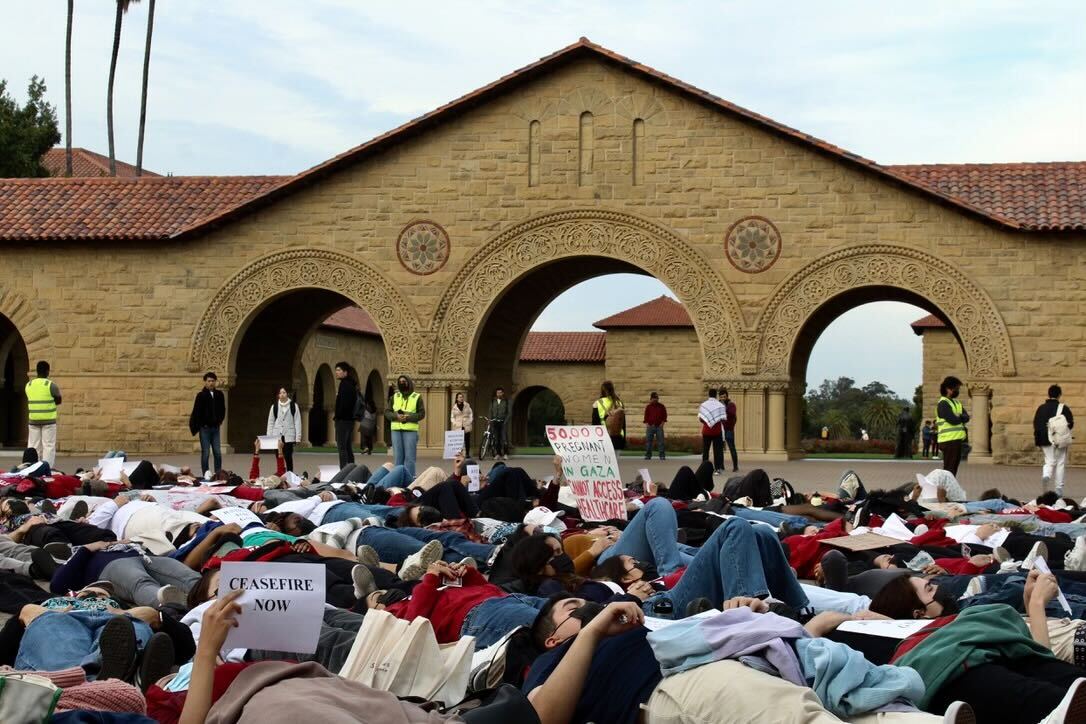Around 150 people participated in a “die-in” organized by Students for Justice in Palestine (SJP) in front of Memorial Church on Thursday. The purpose of the die-in was to mourn and honor the Palestinian civilians killed by Israeli air strikes in the past month, according to organizers.
Participants called on the University to take action on the ongoing Israel-Gaza conflict, including providing resources for Palestinian, Arab and Muslim students and issuing a statement that both denounces Israeli war crimes and calls for a ceasefire. The U.N. High Commissioner for Human Rights Volker Türk condemned the “collective punishment by Israel of Palestinian civilians” and “unlawful forcible evacuation,” along with “atrocities perpetrated by Palestinian armed groups” on Oct. 7, as war crimes.
The organizers also advocated for divesting and boycotting Israeli ventures and academic institutions.
“The die-in’s symbolic,” said one of the organizers of the die-in, who requested anonymity due to fear of physical retaliation. “It’s people laying down to represent their dead brothers and sisters and siblings, like laying in solidarity.”
The demonstration occurred amid Israeli airstrikes and a ground invasion that has killed over 10,000 Palestinians as of Friday, according to the Palestinian Ministry of Health in Ramallah, based on sources in Hamas-controlled Gaza. UNICEF expressed confidence in the death toll.
Israeli retaliation followed an Oct. 7 surprise attack by Hamas that killed more than 1,400 civilians and took over 200 hostages, according to the Israel Defense Forces.
The die-in started at 2:30 p.m., when attendees laid down in a circle with space in the middle reserved for two speakers. Over the next hour, organizers read the names of 630 Palestinian civilians who were killed in the past month, hailing from seven families.
Organizers purposefully chose to read names in order of age from “great-grandparents to great-grandchildren” and separated by family to show attendees and the broader community that “entire apartments and hospitals are being bombed indiscriminately,” one speaker, who did not share their name, said.
Participants wore red, white and Stanford-branded clothes, with some draping themselves in white cloths painted with fake blood. Some held dollar bills with blood stains and signs that read “Stop murdering kids,” “Justice for Gaza” and “Stanford divest now.”
The organizer said the die-in was held in Main Quad because “it is kind of what Stanford’s known for.”
“If you look up pictures of [Stanford] online, it’s Memorial Church, Hoover Tower, it’s the arcades — so, the die-in felt appropriate here,” the organizer said. “Genocide feels like what campus stands for right now.”
Sophie D’Souza, a first-year Ph.D. student in the Graduate School of Education who attended the demonstration, said she felt that the “abundance and … wealth and privilege” on Stanford’s campus “isn’t real” and that there is “so much more outside of this bubble … this microclimate.”
“What is real right now is the suffering and murder that is happening to innocent civilians and innocent Palestinians,” D’Souza said. “I think my being here today was a way to honor their lives and to carry their legacy in whatever work … to make sure that they’re never forgotten.”
The organizer said SJP chose to honor Palestinian civilians through a die-in because of its inherent discomfort.
“You’re not supposed to feel comfortable. You’re not supposed to be happy to be here. You’re not supposed to want to be here. This is not something that we should have to do. But it’s something that we do because if you don’t, nobody else will,” the organizer said.
Some participants tied the die-in’s purpose to larger goals of liberation for Palestinians.
“If I’m going to stand for dismantling systems of oppression … in any place or space, then [this die-in] is definitely part of that larger movement towards liberation,” said Estefania Rodriguez Sanchez, a first-year Ph.D. student in the Graduate School of Education.
Similar demonstrations have occurred at Harvard, Cornell and Duke. At Stanford, the demonstration comes amid an ongoing three-week-long sit-in at White Plaza. Hundreds of students and community members previously participated in a walkout and a rally.
“I think that there’s power in numbers,” said Nallely Aceves M.A. ’19 and a first-year Ph.D. student in the Graduate School of Education. “I feel like we have to use our platform to make sure that we’re honoring those who have been subjected to violence. I think it’s really important to … make sure that as ancestors in training, we’re doing everything that we can to plant seeds of resistance.”
The die-in ended with a moment of silence for the more than 10,000 other victims. Speakers closed the die-in by “imploring” attendees not to view those they honored “as 630 names but 630 people with dreams, aspirations and lives.”
Another organizer of the die-in, who also requested anonymity due to fear of physical retaliation, urged attendees to “bring these conversations outside” of the event.
“If there’s nobody shouting for a cause, then it goes unheard,” the organizer said. “If nobody’s fighting for the people of Gaza, then nothing changes.”
